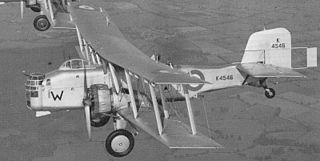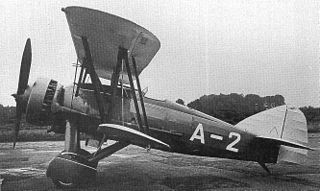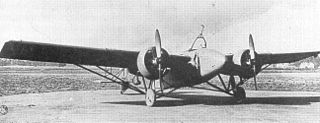
Schräge Musik, which may also be spelled Schraege Musik, was a common name for the fitting of an upward-firing autocannon or machine gun, to an interceptor aircraft, such as a night fighter. The term was introduced by the German Luftwaffe during World War II. "Schräge Musik" was previously a German colloquialism, meaning music that featured an unusual tuning and/or time signature. The standard usage of the adjective schräg is often translated as "slanting" or "oblique", but its slang usage is often translated as "weird" or "strange".

The Blackburn Roc was a naval fighter aircraft designed and produced by the British aviation company Blackburn Aircraft. It took its name from the mythical bird of the tales of the Arabian Nights, the Roc. It was operated by the Fleet Air Arm (FAA) and was active during the Second World War.

The Boulton Paul Defiant is a British interceptor aircraft that served with the Royal Air Force (RAF) during World War II. The Defiant was designed and built by Boulton Paul Aircraft as a "turret fighter" to meet the RAF requirement for day and night fighters that could concentrate their firepower on enemy bombers which were not expected to have fighter escorts due to the distance from Germany to the United Kingdom. The Defiant had all its armament in a dorsal turret offering the ability to fire in most directions. The same principle was used in the Royal Navy's Blackburn Roc which was also built by Boulton Paul.
Boulton Paul Aircraft Ltd was a British aircraft manufacturer that was incorporated in 1934, although its origins in aircraft manufacturing began earlier in 1914 and lasted until 1961. The company mainly built and modified aircraft under contract to other manufacturers, but had a few notable designs of its own, such as the Defiant fighter and the Balliol trainer.

The Hawker Hart is a British two-seater biplane light bomber aircraft that saw service with the Royal Air Force (RAF). It was designed during the 1920s by Sydney Camm and manufactured by Hawker Aircraft. The Hart was a prominent British aircraft in the inter-war period, but was obsolete and already side-lined for newer monoplane aircraft designs by the start of the Second World War, playing only minor roles in the conflict before being retired.

The Boulton Paul P.29 Sidestrand was a twin-engine biplane medium bomber of the Royal Air Force. Designed for daylight operations, it was manoeuvrable and provided with three defensive gun positions. Named after a village on the Norfolk coast near Boulton & Paul's factory in Norwich, the Sidestrand first flew in 1926 and entered service in 1928. It remained in service until 1936, equipping No. 101 Squadron RAF. It was an agile and relatively fast aircraft that was capable of aerobatic manoeuvres such as loops, rolls and spins.

The Boulton Paul P.75 Overstrand was a twin-engine biplane medium bomber designed and produced by the British aircraft manufacturer Boulton Paul. It was the final example of a series of biplane medium bombers that had served in the Royal Air Force since the First World War, starting with the likes of the Vickers Vimy and Handley Page Type O. The Overstrand was also the first aircraft to be fitted with a fully-enclosed power-operated turret.

The Vickers 40 mm Class S gun, also known simply as the Vickers S or S gun, was a 40 mm (1.57 in) airborne autocannon designed by Vickers-Armstrongs for use as aircraft armament.

The Hawker Tornado was a British single-seat fighter aircraft design of the Second World War for the Royal Air Force as a replacement for the Hawker Hurricane. The planned production of Tornados was cancelled after the engine it was designed to use, the Rolls-Royce Vulture, proved unreliable in service. A parallel airframe that used the Napier Sabre engine continued into production as the Hawker Typhoon.

The Hawker Henley was a British two-seat target tug derived from the Hawker Hurricane that was operated by the Royal Air Force during the Second World War.

The Hawker Hawfinch was a British single-engined biplane fighter of the 1920s. It was unsuccessful, with the Bristol Bulldog being selected instead.

The Boulton Paul P.92 was a British design by Boulton Paul for a two-seat, turret-armed, twin-engine heavy fighter and ground attack aircraft to meet Air Ministry Specification F.11/37. Only a half scale prototype – the P.92/2 – was built and tested as check on aerodynamics before the project was cancelled in 1940.

The Gloster F.9/37, also known as the Gloster G.39, was a British twin-engined design from the Gloster Aircraft Company for a cannon-armed heavy fighter to serve with the Royal Air Force, planned before the Second World War. The F.9/37 was rejected in favour of other designs.

The Armstrong Whitworth A.W.16 was a British single-engine biplane fighter aircraft designed and built by Armstrong Whitworth Aircraft. A number were sold to the Chinese Kwangsi Air Force.
The Hawker P.V.3 was a British single-engined biplane fighter prototype of the 1930s. Only a single example was built, the Gloster Gladiator being selected instead to fulfill the requirement to which it was designed.

The Boulton Paul Bittern was a 1920s British night-fighter aircraft built by Boulton Paul Limited of Norwich, named after the marsh bird of the same name.
The Supermarine B.12/36 was a British prototype four-engine heavy bomber design that was destroyed by enemy action before completion during the Second World War.
The Armstrong Whitworth Armadillo was a British single-seat biplane fighter aircraft built by Armstrong Whitworth.

The Austin A.F.T.3 Osprey was a prototype British fighter triplane of the First World War. Developed by the motor car manufacturer Austin as a replacement to the Sopwith Camel, only one was built, the Sopwith Snipe being preferred.
















